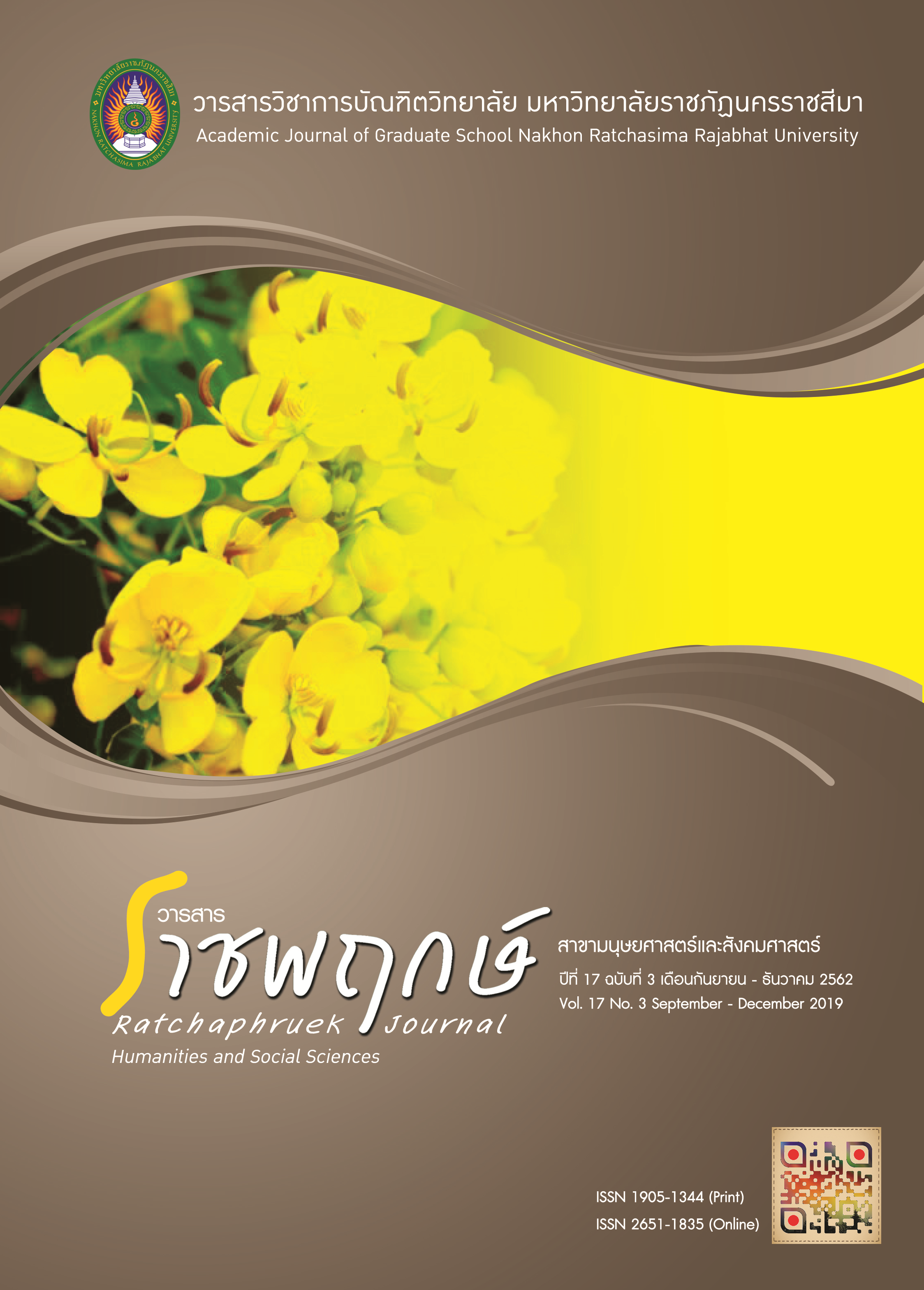The Development of Waggle Courtier Doll Molding
Main Article Content
Abstract
This study aimed to investigate the customers demand on waggle courtier doll molding, to develop waggle courtier doll molding that answers the customers demand and to evaluated customers’ satisfaction toward the waggle courtier doll molding. The four three-dimensional (3D) pattern of waggle courtier doll molding were designed. The pattern will be evaluated and use in further step. The participants were five technicians who are expert in manufacturing and product design. Research instrument was open-ended questionnaire. Pattern number 1 was selected by the technicians because it was the most suitable pattern for the waggle courtier doll molding. The model of waggle courtier doll molding was made. The product will be used as the sample in customers’ satisfaction evaluation step. The participants were 50 customers who are interesting in waggle courtier doll molding. The research instrument was customers’ satisfaction questionnaire. The highest customers’ satisfaction score in each aspect was 1) product design aspect, the customers satisfied the concordant of material and product (=4.96) 2) the beauty of product, the consumers are satisfied the delicate and neat of product (
=4.94) 3) the usefulness aspect, the customers satisfied the safe use of product (
=4.70) and 4) the satisfaction toward whole product, the waggle courtier doll molding gained the customer satisfaction in highest level (
=4.76).
Article Details
References
กนกวรรณ งามฉวี. (2554). การพัฒนาหลักสูตรท้องถิ่นเพื่อสืบทอดภูมิปัญญาการปั้นตุ๊กตาชาววัง (วิทยานิพนธ์ปริญญาศึกษาศาสตรมหาบัณฑิต สาขาวิชาเทคโนโลยีการวิจัยและพัฒนาหลักสูตร คณะคุรุศาสตร์อุตสาหกรรม มหาวิทยาลัยเทคโนโลยีราชมงคลธัญบุรี).
กรีทากร แสงสกุล. (2555). หัตถกรรมดินไทย : กรณีศึกษางานหัตถกรรมดินไทย OTOP ในเขตจังหวัดสมุทรสงคราม นนทบุรี และกรุงเทพมหานคร (วิทยานิพนธ์ปริญญาการศึกษามหาบัณฑิต สาขาศิลปศึกษา มหาวิทยาลัยศรีนครินทรวิโรฒ).
กิติชัย ระมิงค์วงศ์. (2543). ตุ๊กตาชาววัง. ภาควิชาเครื่องเคลือบดินเผา มหาวิทยาลัยศิลปากร.
เกศริน วิโรจน์ชูฉัตร. (2553). ศิลปะประดิษฐ์การปั้นตุ๊กตาด้วยดินไทย. กรุงเทพ มหานคร : สำนักพิมพ์เพชรกะรัต.
ขวัญใจ สุขก้อน, น้ำฝน ลูกค้า และบัญนษร สันฐาน. (2555). การออกแบบตราสัญลักษณ์บรรจุภัณฑ์งานประดิษฐ์จากดินไทย ของกลุ่มงานประดิษฐ์จากดินไทย จังหวัดนนทบุรี (รายงานวิจัย). มหาวิทยาลัยราชภัฏสวนสุนันทา.
ทิพย์วาณี สนิทวงศ์. (2538). ตุ๊กตาชาววังและตุ๊กตาแก้สินบน. กรุงเทพมหานคร : โรงพิมพ์คุรุสภาลาดพร้าว.
บุษกร เข่งเจริญ. (2553). การจัดการแหล่งเรียนรู้ของจิ๋วเพื่อการเรียนรู้วิถีชีวิตไทย (วิทยานิพนธ์ศิลปศาสตรมหาบัณฑิต สาขาวิชาการบริหารงานวัฒนธรรม วิทยาลัยนวัตกรรม มหาวิทยาลัย ธรรมศาสตร์).
บัณฑิต อินทร์คง. (2557). ศิลปะลายรดน้ำและลายกำมะลอ: องค์ความรู้ที่ไม่เคยสูญ. วารสารศิลปกรรมศาสตร์วิชาการ วิจัย และงานสร้างสรรค์, 1(2), น. 168-185.
รัตนาภรณ์ พืชผล. (2541). การพัฒนารายการวีดิทัศน์ เรื่อง “งานปั้นตุ๊กตาชาววัง สำหรับนักเรียนชั้น ประถมศึกษาปีที่ 5 ในโครงการศูนย์ศิลปาชีพบางไทร”. กรุงเทพมหานคร : ฐานข้อมูลวิทยานิพนธ์ไทย.
วรรณณา ธิธรรมมา. (2545). ตุ๊กตาสาธิตการดัดตนแบบไทยโบราณ (วิทยานิพนธ์ ปริญญาศิลปะมหาบัณฑิต สาขาเครื่องเคลือบดินเผา มหาวิทยาลัยศิลปากร).
วลัยลักษณ์ ทรงศิริ. (2536). ตุ๊กตาชาววัง. กรุงเทพมหานคร : สำนักพิมพ์ต้นอ้อ.
วัฒนะ จูฑะวิภาต. (2542). หัตถกรรมไทยความเป็นมาและการผลิตในปัจจุบัน กรณีศึกษา : การทำของเล่นไม้ระกำ (รายงานวิจัย). สถาบันไทยศึกษา จุฬาลงกรณ์มหาวิทยาลัย.
ศูนย์วัฒนธรรมจังหวัดอ่างทอง. (2533). ตุ๊กตาชาววัง. นครสวรรค์ : สำนักพิมพ์สยามศิลป์.
สถาพร ดีบุญมี ณ ชุมแพ. (2550). การศึกษาการออกแบบผลิตภัณฑ์อุตสาหกรรม. กรุงเทพมหานคร : สำนักพิมพ์ โอเดียนสโตร์.
สุนทรียา อนุสนธิ์พรเพิ่ม. (2536). ตุ๊กตาชาววังบ้านบางเสด็จ : ภาพสะท้อนวิถีชีวิตแบบชาวบ้านและวัฒนธรรมไทย กรณีศึกษาตุ๊กตาชาววังบ้านวัดตาลใต้และวัดตาลเหนือ (วิทยานิพนธ์ปริญญาศิลปศาสตร์บัณฑิต ภาควิชามานุษยวิทยา คณะโบราณคดี มหาวิทยาลัยศิลปากร).
อรัญ วานิชกร. (2559). หลักการออกแบบผลิตภัณฑ์ท้องถิ่น. กรุงเทพมหานคร : สำนักพิมพ์แห่งจุฬาลงกรณ์มหาวิทยาลัย.
Boone, H. N., Jr. & Boone, D. A. (2012). Analyzing Likert data. Journal of Extension, 50(2), Article Number 2TOT2.
James, C. & Perla, R. J. (2007). Ten common misunderstandings, misconceptions, persistent myths and urban legends about Likert scales and Likert response formats and their antidotes. Journal of Social Sciences, 3(3), pp. 106-116.
Kvale, S. (1996). Interviews: An Introduction to Qualitative Research Interviewing. London: Sage Publications.
Palys, T. (2008). Purposive sampling. In: Given, L. M. (Ed.) The Sage Encyclopedia of Qualitative Research Methods. (Vol. 2). Los Angeles: Sage, pp. 697-698.
Teddie, C. & Yu, F. (2007). Mixed methods sampling: A typology with examples. Journal of Mixed Methods Research, 77(1), pp. 77-100.


